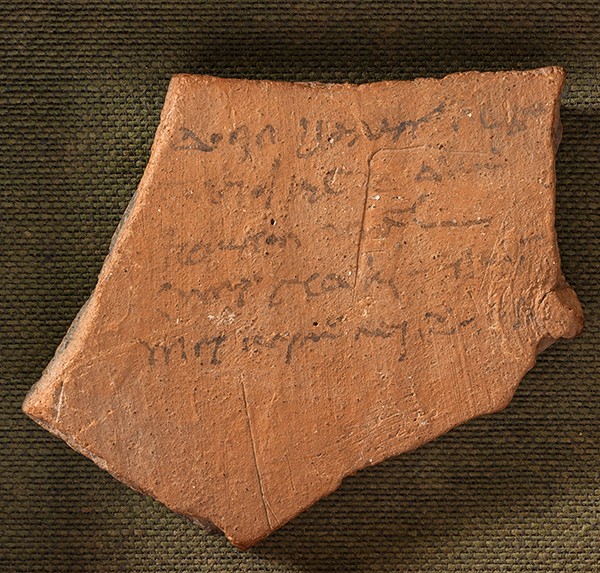Acquisition number: 1991.03
Brown smooth clay with some white inclusions, grey in the core. The fragment is probably from the shoulder of a plainware jar or amphoroid vessel; there are marks on the surface that indicate it came from the proximity of the handle. The inscription is written at right-angles to the wheel-marks on the outer face of the sherd.
The inscription is fairly neatly written in slightly faded black ink and comprises five lines of Greek. It is an acknowledgement of payments of bath tax made by Dekmos son of Heron “for the 5th year for the Northern District”. The first, made on 21 Epeiph (15 July) was of four drachmas; the second; made on the following day, of ten.
Δόσις βαλανε(ίου) ε (ἔτους) βο(ρρᾶ)
Ἐπεὶφ κα- δ(ιὰ) Δέκμο(υ)
Ἥρωνος τοῦ α(ὐτοῦ) (ἔτους)
(δραχμαὶ) τέσαρ(ες) (γίνονται) (δραχμαὶ) δ καὶ τῆι κβ-
ὑπὲρ θερμῶ(ν) μη(τροπόλεως) (δραχμαὶ) δέκα (γίνονται) (δραχμαὶ) ι.
“Payment of bath-tax for the 5th year for Borras on the 21st of Epeiph by Dekmos son of Heron for the same year four dr., total 4 dr. and on the 22nd for the warm baths of the metropolis ten dr., total 10 dr.”
Title: Ostrakon - 1991.03
Acquisition number: 1991.03
Author or editor: J.R. Green
Culture or period: Romano-Egyptian.
Date: 15-16th July, 2nd century AD.
Material: Clay - Terracotta
Object type: Inscriptions
Dimensions: 67mm (w) × 57mm (h)
Origin region or location: Egypt
Origin city: Thebes (Egpyt).
Display case or on loan: 6
Keywords: Roman, Imperial, Romano Egyptian, Inscription, Fragment, Dekmos, Heron, Thebes, Moen Collection
P.J. Sijpesteijn, “A Curious Ostrakon”, Zeitschrift für Papyrologie und Epigraphik 35, 1979, 138, pl. 8a; Charles Ede Ltd (London), Writing and Lettering in Antiquity (1991) no. 29 (ill.).
1991.03
Ostrakon
Formerly in the Moen Collection (Netherlands), no. 30 (inv. no. 114); acquired by the Friends of the Classics Museum. 5.7 x 6.7cm.
Brown smooth clay with some white inclusions, grey in the core. The fragment is probably from the shoulder of a plainware jar or amphoroid vessel; there are marks on the surface that indicate it came from the proximity of the handle. The inscription is written at right-angles to the wheel-marks on the outer face of the sherd.
The inscription is fairly neatly written in slightly faded black ink and comprises five lines of Greek. It is an acknowledgement of payments of bath tax made by Dekmos son of Heron “for the 5th year for the Northern District”. The first, made on 21 Epeiph (15 July) was of four drachmas; the second; made on the following day, of ten.
Δόσις βαλανε(ίου) ε (ἔτους) βο(ρρᾶ)
Ἐπεὶφ κα- δ(ιὰ) Δέκμο(υ)
Ἥρωνος τοῦ α(ὐτοῦ) (ἔτους)
(δραχμαὶ) τέσαρ(ες) (γίνονται) (δραχμαὶ) δ καὶ τῆι κβ-
ὑπὲρ θερμῶ(ν) μη(τροπόλεως) (δραχμαὶ) δέκα (γίνονται) (δραχμαὶ) ι.
“Payment of bath-tax for the 5th year for Borras on the 21st of Epeiph by Dekmos son of Heron for the same year four dr., total 4 dr. and on the 22nd for the warm baths of the metropolis ten dr., total 10 dr.”
One may note that there is separation between the words. P.J. Sijpesteijn, “A Curious Ostrakon”, Zeitschrift für Papyrologie und Epigraphik 35, 1979, 138, pl. 8a compares O.Fay. 6, which is also concerned with the payment of bath-tax, coincidentally for the same amount.
Thebes, 2nd century AD. On ostraka in general, see the excellent article by W.J. Cockle in Oxford Classical Dictionary3 and the references given there, or the collection of items published in J. Bingen et al., Mons Claudianus. Ostraca Graeca et Latina, I (DFIFAO 29, Cairo 1992). There is also an accessible collection in K.A. Worp, Greek Ostraka from Kellis (Oxford 2004). See in general R.S. Bagnall, Egypt in Late Antiquity (Princeton 1993).
P.J. Sijpesteijn, “A Curious Ostrakon”, Zeitschrift für Papyrologie und Epigraphik 35, 1979, 138, pl. 8a; Charles Ede Ltd (London), Writing and Lettering in Antiquity (1991) no. 29 (ill.).
